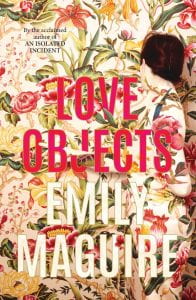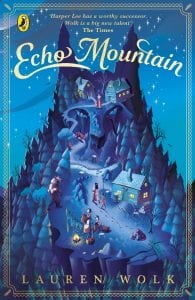 At a time when minimalism is so widely promoted, have you ever wondered about the value you place on objects in your home? Are there precious items you would find it hard to throw out? what if someone else threw out things you valued?
At a time when minimalism is so widely promoted, have you ever wondered about the value you place on objects in your home? Are there precious items you would find it hard to throw out? what if someone else threw out things you valued?
In ‘Love Objects’, 45-year-old Nic would definitely not be a fan of Marie Kondo; although she does believe that everything in her house has a purpose and meaning. However, decades of newspapers stacked in the hall do not deter her from scavenging even more leaflets and envelopes that may someday ‘be useful’.
Many other items she gathers make her ponder their past lives, as she considers their new special place in her home (as Marie might also do). It is the quantity of items she loves that provides a catastrophic turning point in her life; Nic has a fall, her hoard comes tumbling down and well-meaning family members arrive to take charge.
Family relationships can be a curious thing – especially when life hiccoughs get in the way. Nic has no children, but has always been close with her niece, Lena. Until her sister, Michelle, moved her family away, she enjoyed fun times with Lena and her brother, Will. Then, time and distance and failed relationships over the years set other securities in motion.
Emily Maguire cleverly introduces the idiosyncrasies of hoarders in the opening chapter – the way she writes, the way she voices what Nic is feeling – and sets up the chain of events to follow. It is awkward reading, but nuanced to the character of Nic.
The web woven for Lena is also cleverly set, as she follows her attraction for a fellow uni student. She is oblivious to his grooming efforts and is soon, so easily, a victim, in spite of some awareness of sexual assault issues at uni. Much of what happens to her, consumes her and looks to ruin her life ambition.
Many questions arise from reading ‘Love Objects’. What would you have done if you were Lena? her mother Michelle? Could you have done something differently, earlier, if you were Nic? an aware Lena? a different sister version of Michelle? Would it have made a difference?
Hear what Emily Maguire has to say about ‘Love Objects’ here:
After you read ‘Love Objects’, what would feature in a sequel? How would you write the future of the Mitchell family?
 Once there were wolves in Scotland – until they were viewed as too great a threat to farmers and their animals. In fact, in 1577, James VI made it compulsory to hunt wolves three times a year.
Once there were wolves in Scotland – until they were viewed as too great a threat to farmers and their animals. In fact, in 1577, James VI made it compulsory to hunt wolves three times a year. Through Inti’s experiences, Charlotte McConaughy writes a sensitive and sensual discovery of the need to accept the role of wild creatures. Some locals are won over, but fear of the unknown echoes through much of the population.
Through Inti’s experiences, Charlotte McConaughy writes a sensitive and sensual discovery of the need to accept the role of wild creatures. Some locals are won over, but fear of the unknown echoes through much of the population. Some time ago, I heard/read that what defines YA apart from adult fiction is the notion of ‘hope’. (I need to research where this was…). And having just finished ‘The Boy Who Steals Houses’ I have a clear example of this idea.
Some time ago, I heard/read that what defines YA apart from adult fiction is the notion of ‘hope’. (I need to research where this was…). And having just finished ‘The Boy Who Steals Houses’ I have a clear example of this idea. Here is one for lovers of crime fiction – a more mature read for senior students and adults. ‘The Ruin’ is the first novel for Irish-born author Dervla McTiernan – the first of (now) several books centred on Garda Cormac Reilly.
Here is one for lovers of crime fiction – a more mature read for senior students and adults. ‘The Ruin’ is the first novel for Irish-born author Dervla McTiernan – the first of (now) several books centred on Garda Cormac Reilly. As I delved into family history and considered the troubles my ancestors dealt with, I was also reading ‘Echo Mountain’, and then reflected on what many people faced in the years of the Depression when they lost their jobs and livelihoods.
As I delved into family history and considered the troubles my ancestors dealt with, I was also reading ‘Echo Mountain’, and then reflected on what many people faced in the years of the Depression when they lost their jobs and livelihoods. It’s a mystery – Laney is missing and Stacey doesn’t believe the story told by Laney’s boyfriend, Troy.
It’s a mystery – Laney is missing and Stacey doesn’t believe the story told by Laney’s boyfriend, Troy.
 After reading Favel Parrett’s
After reading Favel Parrett’s  Rey (Raze to his friends) has a few other instincts which he can’t really explain – although he thinks it may have something to do with his family heritage as the son of mafia boss. He has something to tell his father when he next visits him in prison – but what is it?
Rey (Raze to his friends) has a few other instincts which he can’t really explain – although he thinks it may have something to do with his family heritage as the son of mafia boss. He has something to tell his father when he next visits him in prison – but what is it? This story oozes feelings and emotions; even in the little things. As you read, you can taste the meals Lucek has with his grandmother. They are deliciously described, even though they may be simple fare. You can also sense the atmosphere of their humble accommodation – a small apartment in Prague.
This story oozes feelings and emotions; even in the little things. As you read, you can taste the meals Lucek has with his grandmother. They are deliciously described, even though they may be simple fare. You can also sense the atmosphere of their humble accommodation – a small apartment in Prague.